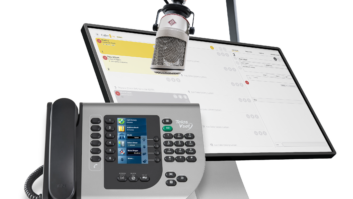PETALUMA, Calif. — I’m the host of “The Tech Guy” show on the Premiere Networks. As the “tech guy” I have to use the latest hardware and software, and it better work, or I’m the “wreck guy” and all my credibility is shot. That’s why I rely on equipment from The Telos Alliance for my entire audio workflow, including my new Telos VX phone interface.

Leo Laporte with the Telos VX Phone System When I started hosting the show in 2004 I used an analog Mackie mixer and Telos Zephyr with ISDN to send my audio from my northern California “studio” — really a converted attic room in a former bed and breakfast — to the studios of KFI(AM) in Los Angeles. Call screening was handled in L.A. I controlled the calls locally by VPNing into the L.A. studio and running vintage 1998 call screening software on a Windows XP laptop. I didn’t dare update either the software or the laptop for fear the entire house of cards would crumble.
MOVING UP
Fast forward a decade. In the intervening years “The Tech Guy” had grown into a podcast network, TWiT, with two dozen shows and more than 7 million downloads a month. We moved the operation from the garret studio to a 10,000-square-foot studio designed for audio and video production. We’d also upgraded my little analog mixer with a state-of-the-art Axia Element digital console and routing system. The Axia proved a perfect solution for our big studio — allowing us to put mics anywhere and route the audio everywhere. With six sets and 25 shows the Axia system made it possible to produce network-quality audio programming with very little training.
In 2007 the radio show expanded from KFI to 200 stations on the Premiere Networks, but the call screener remained in southern California using that same ancient software. We were getting considerable latency introduced into the calls, resulting in an intermittent echo that didn’t go out over the air, but drove me crazy.
After much troubleshooting, Premiere’s Senior Vice President of Engineering Bill Hickey decided to move the call screener up to Petaluma, eliminating the latency. And naturally, since we were a happy Axia house we decided to upgrade to a Telos VX phone interface. The Telos VX a multiline, multistudio on-air phone system that works with almost any kind of phone line and interfaces to any audio console.
Kirk Harnack and his team at Telos made it trivially easy to install and configure the system. It integrates with Axia’s Livewire IP audio standard. The Web-based interface and configuration pages are similar to the equipment we were already using so my studio engineers took no time getting up to speed. Telos sent an engineer who installed the POTS interface and integrated the VX system with the Axia. We were up and running perfectly in just a few days.
The handset interface and the call screener software are complementary and straightforward. I may be “The Tech Guy” but that doesn’t mean I want to suffer with a complicated or opaque handset UI during my show. The VX is a breeze to use, and I’m happy to say the echo has been eliminated. Even though the quality of the incoming calls can vary widely, the Omnia audio processing in the VX does an excellent job of maintaining optimum caller levels — which means I don’t have to ride gain on the board.
In sum, we’re super happy with our VX system. It works hand-in-hand with our Axia and digital Zephyr Xstream to make my job easy. And our engineers love the quick and helpful support Telos provides whenever we have a configuration question. Thanks to the Telos VX, “The Tech Guy” really looks like he knows what he’s doing.
For information, contact Angi Roberson at the Telos Alliance in Ohio at (216) 241-7225 or visit www.telosalliance.com.












